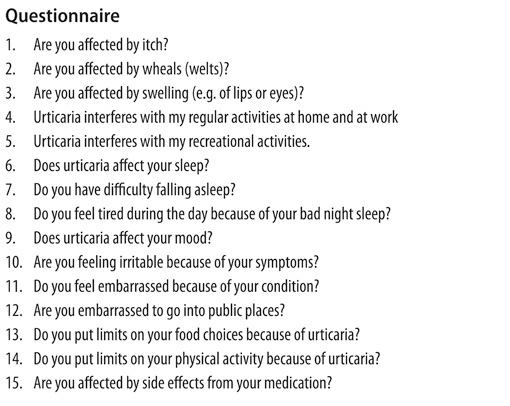Asia Pac Allergy.
2011 Apr;1(1):25-29. 10.5415/apallergy.2011.1.1.25.
Impact of chronic urticaria on the quality of life in Australian and Sri Lankan populations
- Affiliations
-
- 1Campbelltown Hospital, Campbelltown NSW 2560, Australia. chk@allergyimmunol.com.au
- 2Faculty of Medicine, University of Kelaniya, Kelaniya 11600, Sri Lanka.
- KMID: 2397142
- DOI: http://doi.org/10.5415/apallergy.2011.1.1.25
Abstract
- BACKGROUND
Chronic idiopathic urticaria (CIU) has a significant impact on patients' quality of life.
OBJECTIVE
The purpose of this study is to assess that impact and to compare differences by culture, gender, age or duration of treatment.
METHODS
We used the modified chronic urticaria quality of life questionnaire, consisting of 15 questions. Over the course of 6 months, patients attending Immunology clinics at Campbelltown Hospital and private rooms in Australia and at the faculty of Medicine, University of Kelaniya in Sri Lanka were asked to fill out the questionnaires. We have obtained the data from 125 patients (43 Australian vs. 82 Sri Lankan). There were significantly more female patients (P < 0.01). The data was analysed using SAS.
RESULTS
Overall, patients were affected mostly by itch and wheals and least affected by the side effects of treatments. Sri Lankan populations were more affected by wheals and by interference on activities, mood and food choices but were less affected by tiredness due to sleep disturbances (P < 0.01). Females were more affected by sleep disturbance (P < 0.05) while those older than 40 years of age were more impacted by tiredness and by the side effects from medications (P < 0.05), though the complaints themselves were mild. Those who suffered from CIU for more than 1 year were more affected by wheal, tiredness and irritability (P ≤ 0.05).
CONCLUSION
The questionnaire highlighted some differences between patients attending Australian versus Sri Lankan outpatients. Significant differences were found in one third of parameters which include mood, sleep, daily activities and food choices.
Keyword
MeSH Terms
Figure
Cited by 2 articles
-
A study of treatment adherence and quality of life among adults with chronic urticaria in Singapore
Jun Khee Heng, Li Jia Koh, Matthias Paul Han Sim Toh, Derrick Chen Wee Aw
Asia Pac Allergy. 2015;5(4):197-202. doi: 10.5415/apallergy.2015.5.4.197.Role of bilastine in the management of allergic rhinitis and urticaria: an Asia-Pacific consensus statement
Ralph Mösges, Dennis Lip Yen Lee, Jovilia Abong, Bella Siasoco, Steven KW Chow, Jern-Lin Leong, Harvinder Singh, S Kuljit, Benjamin Campomanes
Asia Pac Allergy. 2016;6(1):56-66. doi: 10.5415/apallergy.2016.6.1.56.
Reference
-
1. Greaves M. Chronic urticaria. J Allergy Clin Immunol. 2000. 105:664–672.
Article2. O'Donnell BF, Lawlor F, Simpson J, Morgan M, Greaves MW. The impact of chronic urticaria on the quality of life. Br J Dermatol. 1997. 136:197–201.3. Baiardini I, Giardini A, Pasquali M, Dignetti P, Guerra L, Specchia C, Braido F, Majani G, Canonica GW. Quality of life and patients' satisfaction in chronic urticaria and respiratory allergy. Allergy. 2003. 58:621–623.
Article4. Poon E, Seed PT, Greaves MW, Kobza-Black A. The extent and nature of disability in different urticarial conditions. Br J Dermatol. 1999. 140:667–671.
Article5. Grob JJ, Revuz J, Ortonne JP, Auquier P, Lorette G. Comparative study of the impact of chronic urticaria, psoriasis and atopic dermatitis on the quality of life. Br J Dermatol. 2005. 152:289–295.
Article6. Baiardini I, Pasquali M, Braido F, Fumagalli F, Guerra L, Compalati E, Braga M, Lombardi C, Fassio O, Canonica GW. A new tool to evaluate the impact of chronic urticaria on quality of life: chronic urticaria quality of life questionnaire (CU-Q2oL). Allergy. 2005. 60:1073–1078.
Article7. Wolfrom E, Chêne G, Boisseau H, Beylot C, Géniaux M, Taïeb A. Chronic urticaria and Toxocara canis. Lancet. 1995. 345:196.
Article8. Humbert P, Niezborala M, Salembier R, Aubin F, Piarroux R, Buchet S, Barale T. Skin manifestations associated with toxocariasis: a case-control study. Dermatology. 2000. 201:230–234.
Article9. Li RHY, Wing YK, Ho SC, Fong SYY. Gender differences in insomnia - a study in the Hong Kong Chinese population. J Psychosom Res. 2002. 53:601–609.
- Full Text Links
- Actions
-
Cited
- CITED
-
- Close
- Share
- Similar articles
-
- A study of treatment adherence and quality of life among adults with chronic urticaria in Singapore
- Neglecting the neglected during the COVID-19 pandemic: the case of leptospirosis in Sri Lanka
- Urticaria: Classification and Diagnosis
- Validation of Sinhala Version of Cardiff Wound Impact Schedule in Patients with Diabetic Leg and Foot Ulcers
- Etiology and Treatment of Chronic Urticaria


